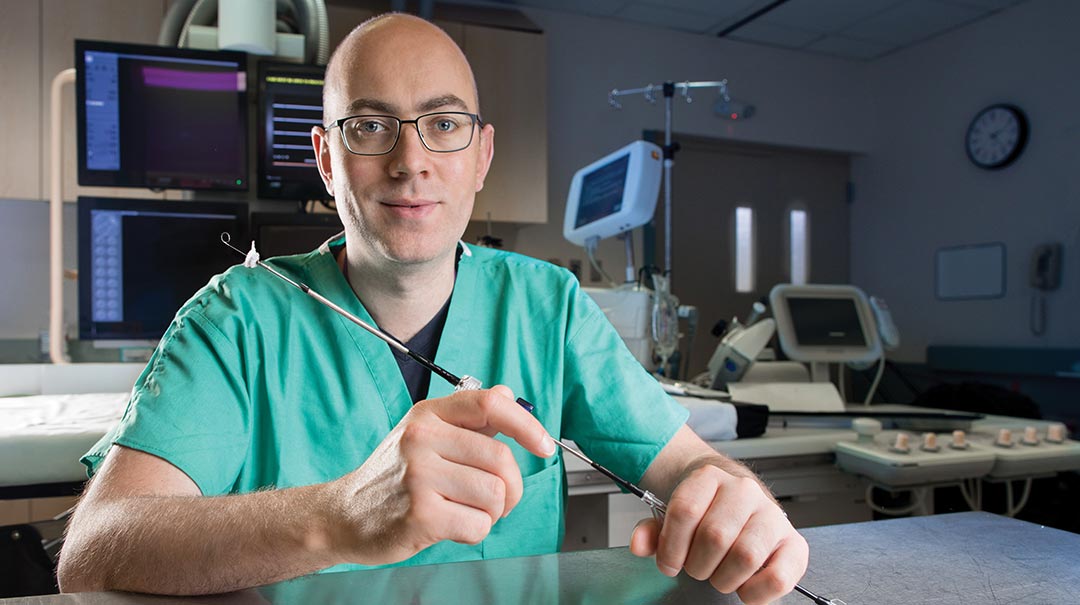Find care now
If you are experiencing a medical emergency, please call 911 or seek care at an emergency room.

Aortic stenosis, a common condition in older adults, is caused by the progressive narrowing of the aortic valve, the main heart valve through which blood flows from the heart to the rest of the body. As the valve gets progressively tighter over time, people can begin to experience symptoms—especially when they’re walking or being active. The most common symptoms include:
- Shortness of breath
- Chest pain
- Dizziness
In the past, the only treatment for aortic stenosis was open-heart surgery, which involves putting patients to sleep, stopping their heart, making an incision in the chest, removing the old heart valve, and sewing in a new one. Now, a technique called transcatheter aortic valve replacement (TAVR), allows doctors to replace the narrowed heart valve through a small catheter inserted through the groin without the need for general anesthesia.
Initially only available to people who were too ill to undergo open-heart surgery due to underlying health conditions of the kidneys, lungs, or liver for example, clinical trials have shown that TAVR is a good treatment for most—if not all—patients with aortic stenosis.
LISTEN: Dr. Rogers discusses TAVR for aortic stenosis in the Medical Intel podcast.
How TAVR Works
TAVR begins with patients receiving sedation that makes them feel relaxed and sleepy. Doctors introduce the new heart valve through the artery in the groin and position it inside the heart, using X-ray and ultrasound to precisely position the new valve inside the old narrowed valve. Then, the new heart valve is implanted inside the old valve, opening and closing with every heartbeat.
Because TAVR is less invasive than open-heart surgery, the recovery after TAVR is much faster. Patients typically go home in two to three days, compared to a week for surgery. Of course, every patient is different, however. Most patients go home to recover, but others may require rehab after the procedure to rebuild their physical strength.
Related reading: TAVR is used for high-risk aortic stenosis patients. Why not everyone?
A TAVR Success Story
We saw one patient who had successful open-heart surgery 10 years prior to replace a valve. However, prosthetic heart valves don’t always last a lifetime, and his replacement heart valve started getting tight again. Initially, he was worried about the idea of undergoing open-heart surgery again—until he learned about TAVR. He underwent TAVR, received a new heart valve, and went home the next day. Today, he continues to be overjoyed with the results.
Preparing for TAVR does require patients to undergo a number of scans and tests, so doctors can carefully plan the procedure. We typically perform these tests a few weeks before the actual TAVR procedure. Most patients will come into the hospital the night before the procedure to ensure they are ready for surgery the next day.
Expert Care at MedStar Heart & Vascular Institute
The team of cardiologist and cardiac surgeons at MedStar Heart & Vascular Institute at MedStar Washington Hospital Center were part of the first wave of U.S. hospitals to perform TAVR more than 10 years ago. Today, our experts have performed almost 2,000 of these procedures. We’re also very active in research, which allows us to offer patients access to the latest treatments and technologies.
In 2016, we received approval from the Food and Drug Administration (FDA) to launch the first-of-its-kind clinical trial in the United States to evaluate whether TAVR is a good treatment option for younger low-risk patients, who would currently be recommended to undergo surgery for aortic stenosis. The results of the trial, published online in last year’s Journal of the American College of Cardiology, showed no deaths or disabling strokes within 30 days of undergoing the procedure for 200 low-risk patients who participated in the study. These results provide a strong signal that is just a matter of time until TAVR is approved for general use.














